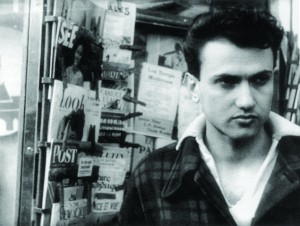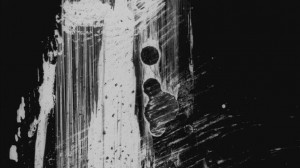The novel in question, my third and last to date, The Best of Brand X, was written in New York and Paris in the late 1960s and early 70s. My first two novels, also unpublished, written successively in high school (The Manufactured Country, 1961) and college (Away from Here, 1965), were both partially autobiographical family chronicles that mainly juggled with the same characters and materials; the third was more experimental and abstract but no less personal. — J.R.
Mr. Deejay Pays a Visit
Mr. Deejay has a long way to go. Straight through a bumper crop of twenty thousand of his listeners -– all of them senior citizens of the lower and middle income brackets, planted in the hot Texas ground up to their necks, each bearing a set of earphones that enclose their gravestone faces like parentheses. A long, long way to go past nurses with medical carts and trays on the narrow paths dividing the twenty thousand heads into neat rows, carry a hand-mike with him as he chatters compulsively against the midsummer heat: “Hot piece-a weather we’re havin, 96 degrees and cloudless sky here on Havingford Acres, givin these people some cool hot-weather music with lemonade, iced tea and all the best medication to see that they look up at the day and smile, my name’s Mr. Read more
mubi.com/notebook/posts/out-1-solitaire
The following “messages” were sent to Kevin B. Lee as part of the preparatory work for our video Out 1 Solitaire: Part of the impact of Out 1 derives from the way
mubi.com|By Jonathan Rosenbaum and Kevin B. Lee
[09/30/14]
Read more
From the Chicago Reader (March 7, 1996). — J.R.


It’s a contradiction in terms to speak of a classic avant-garde film — especially one that aims at both extreme provocation and innovation — but this rarely screened masterpiece (1951) by Jean-Isidore Isou, poet and founder of the French Lettrist movement, qualifies if anything does. Beginning, like a book, with a catalog of all the previous works by the same author, it proceeds with a lengthy account of an impassioned theoretical debate following a Paris cine-club screening, then with a love story of sorts, but the film’s narrative and dialogue are recounted almost entirely offscreen, in voice-overs; what we see is the hero walking in Paris’s Left Bank in the early 50s, eventually followed by other kinds of shots that are sometimes viewed upside down and often scratched over in various ways, making this partially an animated film. Though some of the rhetoric is dated (mainly a misogynistic rant or two, and some anti-jazz invective as objectionable as Theodor Adorno’s), the direct address to the audience via titles and commentary couldn’t be more pointed, and the passion of the whole enterprise is often breathtaking. As an indication of how influential this movie was and is in France, the last sequence of Olivier Assayas’s Irma Vep (see separate listing) would be unthinkable without its example. Read more




